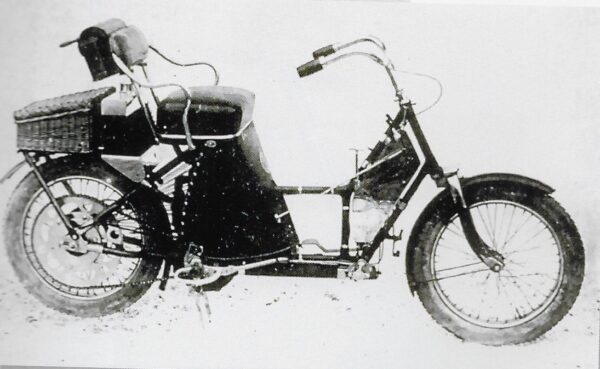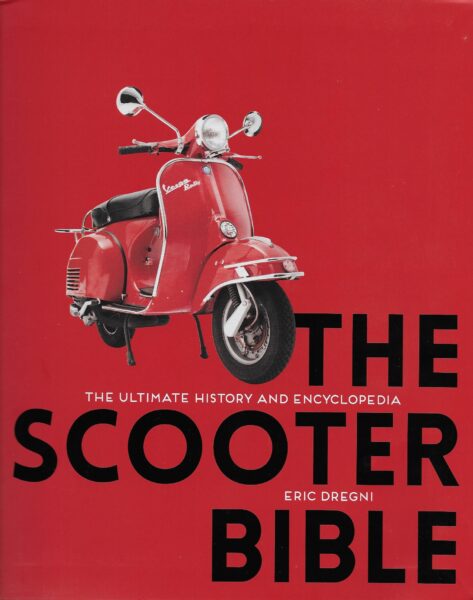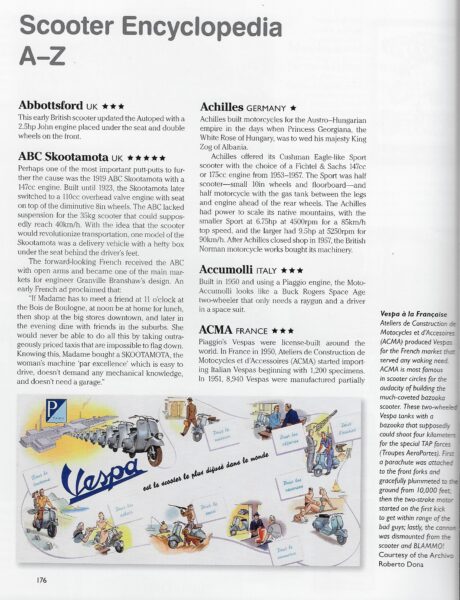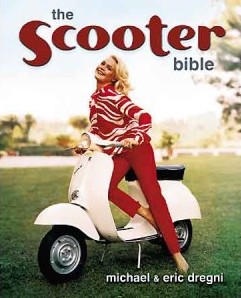Some riders may have vague knowledge that the original Indian “motocycle” company was founded in 1901 and that Harley-Davidson appeared in 1903. Together, they made motorcycling popular in the U.S. in the early 20th century.
In-between the founding of those two companies, across the Atlantic Ocean in 1902, Frenchman George Gauthier also joined an engine to a bicycle, but it was a bike with a step-through frame.
Voila, the debut of the scooter.

Gauthier’s “Auto-Fauteuil must have seemed like a Jules Verne spaceship came to land on the cobblestone streets,” Eric Dregni writes in “The Scooter Bible – The Ultimate History and Encyclopedia.” It did look futuristic with pull-back handlebars, a seat seemingly stolen from a period barber chair, and a cowling below the seat “to shield riders from the messy engine.”
Nonetheless, it “won the dubious honorary title of first motorscooter,” although it didn’t bring to common usage such terms as scooting for riding a scooter or scooterist for a scooter rider.
According to Dregni, early scooters were “gee-whiz gizmos … so far out, so amazing, so unbelievable, that someone somewhere probably quickly derided them as a portent of the coming of the apocalypse.”

Today, much more refined scooters continue as a lower-cost, high-mileage form of two-wheeled transportation. Over the years, they’ve appeared in movies, notably 1953’s “Roman Holiday” with Gregory Peck and Audrey Hepburn, and have served as an accessory of the “mod” subculture in England in the early- and mid-1960s.
Dregni reports that more than 25 million scooters have been sold over the decades, a total that seems awfully low given the durability of the Vespa brand and the recent influx of cheap models from China.
“The Scooter Bible” is an exhaustively researched treasure of pictures, old advertisements and minutia. It recounts history and lore, stunts and promotions, and even has a cartoon.

Amazingly, the comprehensive brand encyclopedia at the rear of “The Scooter Bible” lists more than 500 different makes that have been produced over the decades, including by, yes, Indian and Harley-Davidson. Lambretta models cover more than five pages and Cushman models more than nine pages in the book, while Piaggio/Vespa models occupy more than 11 pages.
With gas prices hitting record levels, the timing perhaps could not be better for “The Scooter Bible” to be released (the publication date is June 21) as presumably interest in scooters will rise once again. The book provides solid background on the segment, recalling well-known brands from the past and continuing to the current day with BMW and others.

“The Scooter Bible” is actually an update from the original edition issued in 2006. A lot has happened in the past 16 years, including the entry of electric scooters. While a chasm once existed between scooter and motorcycle owners, I know several folks who embrace both styles of riding and have a scooter to complement their motorcycles.
Already enjoying ongoing urban popularity, perhaps scooter riding will find even broader acceptance in the coming years as aging riders step away from motorcycles and young adults seek ways to save money. “The Scooter Bible” serves to advance the scooter niche.
Hello! If you enjoyed this story, please share it with other riders by clicking on the social media buttons below.
 Ride CT & Ride New England Serving New England, NYC and The Hudson Valley!
Ride CT & Ride New England Serving New England, NYC and The Hudson Valley!

